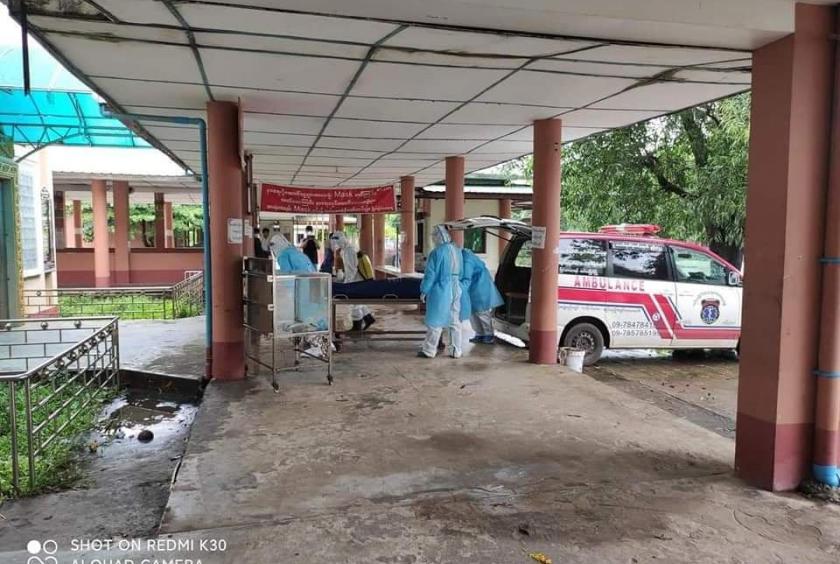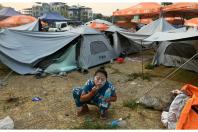Cases of Covid-19 had escalated at a rapid pace starting May 27, now averaging out to around 220 new cases every single day with an infection rate of over 10 percent.
As of now, the places with the most cases of Covid-19 are Sagaing Region, Yangon Region and Bago Region, in a lowering order. Other regions are also seeing climbing numbers.
Situation across states and regions
According to data from the Ministry of Health and Sports (MOHS), Sagaing Region saw the most number of cases with over 1100 new cases in 10 days between June 13 to 23. Yangon has over 700 and Bago is now at over 600.
Tests conducted at the Mahawthadar private basic education highschool after a female student lost her sense of smell revealed over 300 more positive cases in Hlegu, Yangon Region.
MOHS had said that Hlegu General Hospital, Hlaingtharyar's General Hospital and Covid-19 center (Phaungyi) will systematically treat patients that showed symptoms.
In townships across Mandalay, over 400 new Covid-19 cases were found between June 1 and 24.
In select townships across some regions and states, rising number of Covid-19 cases had forced schools that had recently reopened to close indefinitely with some hospitals and markets being shut down.
"It used to be that if one became positive in a family of five, maybe one or two will get infected. But now, if one is positive in a family of six, five people are getting infected so the infection rate is quick. As of the severity, it isn't confirmed but there are relations between severe symptoms, hospitalization and death after hospitalization. We cannot make light of this," said an official from the communicable diseases eradication department.
Townships ordered to stay home
So far, as of the end of may to June 25, there have been nine townships that were placed under the stay-at-home program.
There are five in Chin State, two in Sagaing Region and two more in Bago Region.
"If people from those townships are to visit other places, they will be checked and if results are negative, they will be quarantined for 10 days. If positive, guidelines already in place will be followed. Those not from there can proceed on as normal but it may change depending on the situation," said the official.
Even those that have been vaccinated but are living in Stay-at-home townships must follow directives set up for them.
"People cannot leave their homes unless necessary. Only one leaves the house at one time. For medical reasons, one person can accompany another. If needed, permission must first be sought from respective authorities. It doesn't matter if they are vaccinated or not, they cannot roam outside. This needs to be made clear."
Rising infection rates
It started on May 27 with 96 new patients found. It quickly rose to 122 on June 1 and almost double that by June 4 at 212.
By June 19, it was at 561 new Covid-19 cases found and spiking hard on June 24 with 859. This was a total of 8270 new cases in a month.
This is an increase of a 5.37 percent infection rate on May 27 up to 14.67 on June 25, according to data from the MOHS.
The status of the vaccination
The vaccination against Covid-19 began this year in January with the first wave of Covishield vaccines innoculated to selected groups of people for the first phase. The second phase began on May 31 at the Myanmar Convention Center in Mindamma Road.
"If we can get our hands on vaccines, the vaccination is the most important. Most countries have a low rate of vaccination even in developed nations. The US and UK is at 40 percent and only Israel is over 50 percent. It is severely restricted in 92 developing countries, including ours. I would like to urge getting vaccinated if you have the chance to. So people ask which vaccine is the best and whatever that is being vaccinated in the country is the best because it is what we got," said the same official from the communicable diseases eradication department.
Myanmar currently has access to India-made Covishield and China-made Sinopharm. Both are recognized by the World Health Organisation amongst 8 types to be used in emergency.
An agreement has been made with India for the purchase of 30 million doses of the vaccine but had since been halted as India is also seeing rapid climb in Covid-19 infections.
The MOHS's data say that there are 1.4 million people already vaccinated twice while 1.8 people have been vaccinated once.
"There are 300 thousand more doses of vaccines donated by China. So those are for 150 thousand people. Since schools have been reopened, priority have been given to vaccinating teachers, according to rations depending on each state and regions. Some places already saw two vaccinations while some only has one. It depends on our priority list and the amount of vaccines available to us. Since we only have enough for 150 thousand people, it is limited. So we cannot fully inject Sinopharm for all citizens but efforts are being made in multiple ways to obtain more vaccines from different countries. Also the ones that we bought from India," said the official.
The WHO had persuaded member nations to assist other nations in achieving at least 10 percent of population to be vaccinated by September this year.
The variants
Lab results from cases, especially those from Sagaing Region and Chin State, show the presence of the much dreaded mutated variants.
There were 11 total found so far with traces of the mutant strains. One in Kalay, three in Myeik, four in Mandalay, two in Tamu and one in Yangon, who was an repatrirate.
The Alpha variant infected two, Delta five and Kappa with four. They were originally found and reported in India, the USA, France, Germany, Spain, Ireland and Switzerland.
"Alpha and Delta is special because out of all the variants of concern, they are much more infectious. Even comparing Alpha and Delta, the latter is 60 percent more infectious than the former. However, it is 60 percent and not 60 times faster. Alpha, while not having the exact measurement of its infection rate, is definitely faster than the normal version. The other quality of the two variants is that it is much more likely to infect the family members," said the official.
Treatment programs
As of now, the Yangon General Hospital and North Oakkalapa General Hospital is accepting Covid-19 patients with severe symptoms, 24 hours and free of charge.
"The YGH and the NOGH is accepting patients around the clock. Some don't even know that the YGH Is accepting patients. It started since the 22nd. But that doesn't mean that if you cough, have a fever or show other Covid-19 symptoms, you can straight away come to the YGH. You have to first go to respective public health clinics or hospitals. After they check and results show to be positive, respective hospitals will handle the case first."
According to the MOHS, the YGH, NOGH and Phaung Gyi General Hospital are reserved for those with severe symptoms and are elderly with chronic underlying diseases with oxygen levels below 90.
Close contacts of positive cases will be sent to quarantine centers that relates to each respective townships with many public hospitals readying isolation wards to be able to treat all positive patients.
"If Covid-19 is found, judgement will be made depending on whether sympytoms are showing or not. If no symptoms show or just show regular symptoms, depending on the differences, they will be kept isolated and treated. So they may or may not need to be hospitalized. For example, the Mahaw Thadar School cases were kept in isolation. We check their blood pressure, measure oxygen levels, check for fevers and other health check ups every day. A separate medical team handles those tasks," said the official from from the communicable diseases eradication department.

















